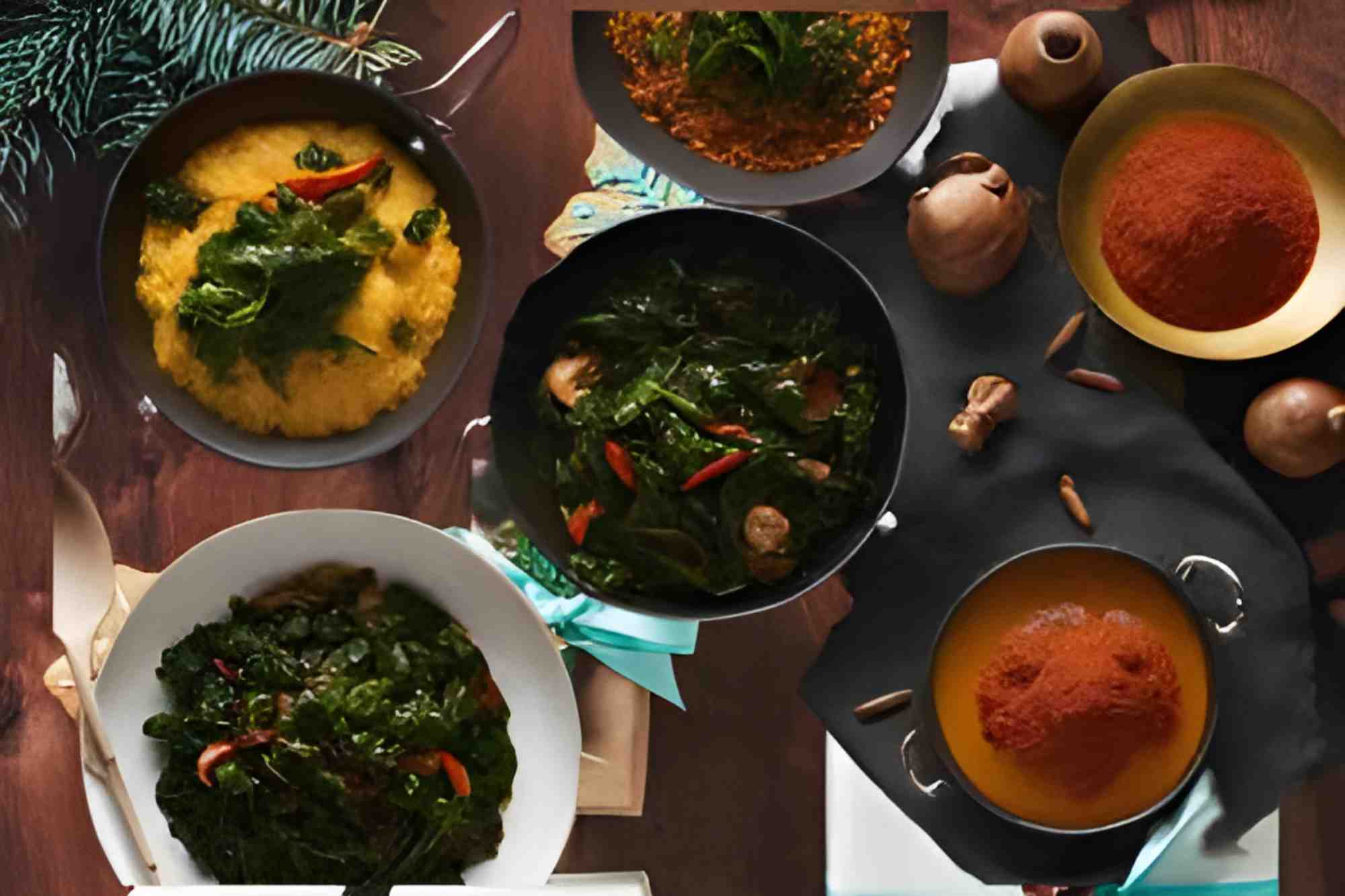Entering the world of buší, an ancient board game and traditional Congolese dish, is like entering a multidimensional world of discovery. It offers a tapestry of flavours, techniques, and stories that transcends culinary boundaries, all while drawing from its historical roots and a variety of cultural influences.
A Preface to a Gastronomic Wonder
Fundamentally, this is a traditional Congolese dish that is known for its flavorful fusion of stir-fried leafy greens, such as cabbage, kale, collard greens, and chilli peppers. This culinary masterwork is usually made by tossing the greens in palm oil and serving them with a mixture of onions, garlic, and spices like bay leaves and nutmeg. The dish is frequently served with fufu, a starchy side made from rice, plantains, or boiled and mashed cassava.
This reveals a history spanning thousands of years, tracing its origins to the Luba people of southeast Congo. In the present era, it has crossed borders and spread into neighbouring African nations, crossing the Congo. It tastes great, and the green parts have important vitamins and nutrients, making it a healthy part of Congolese cooking.
The Origins: Beyond Culinary Horizons
However, the term “buší” holds a dual identity, transcending the kitchen and venturing into the realm of ancient board games. Originating in Egypt around 3500 BCE, its board game emerged as an evolution of earlier hunt games, captivating individuals across all social classes. An intriguing aspect lies in the game’s archaeological presence, with dishes boards discovered in pharaohs’ tombs, underscoring its cultural significance.
The game traversed through neighboring civilizations, evolving into diverse versions embraced by ancient Mesopotamians, Greeks, and Romans. From simple grids of lines and spaces, the buší board game evolved, incorporating intricate patterns, special spaces, and diverse piece movements. By 500 BCE, the modern cross-shaped pattern emerged, setting the stage for a game that blends strategy, luck, and a dash of combat.
The Culinary Symphony: its Ingredients Unveiled
Switching gears from game boards to kitchen tables, the distinctive Ecuadorian version of this dish introduces a culinary symphony of flavors. The dish features a delectable combination of meat—typically beef, pork, or chicken—seasoned with garlic, cumin, oregano, and chili peppers. Ripe plantains contribute a starchy and slightly sweet component, either mashed into the dish or fried as a garnish.
Fresh cheese, often made from cow’s or goat’s milk, melts into this dish, creating a creamy texture. Achiote oil, derived from annatto seeds, imparts the dish with its characteristic orange-red hue and earthy, nutty flavor.
Optional additions like corn, peppers, tomatoes, cilantro, avocado, or fried pork rinds enhance the dish’s complexity, providing a canvas for personalization and regional variations. In summary, the combination of these key ingredients forms the foundation of the dishes, a distinctive Ecuadorian comfort food that delights the palate with every bite.
Crafting the Authentic dishes Experience at Home
Cooking authentic dishes at home requires creativity and careful attention. To elevate your cooking skills, you’ll need basics like rice, corn, fresh seafood, lime, chile peppers, coconut milk, and veggies like okra and eggplant. Essential spices include annatto seeds, cumin, ginger, and turmeric for that rich flavor in the fish dish.
Techniques like braising, stewing, simmering, and frying in coconut or annatto oil infuse layers of flavor into the ingredients. Marinating seafood or meat in citrus juices adds a tangy kick, breaking down fibers and enhancing tenderness. Grinding or pounding spices before adding them to dishes releases essential oils, elevating the aromatic profile. Achieving a balance of heat, sourness, and savouriness involves adjusting chili peppers, lime juice, and soy sauce or fish sauce.
Exploring classic home-style dishes like Kelaguen, Tinaktak, or Guam chili pepper water provides a gateway to the unique fusion of flavors embedded in Chamorro cuisine. Each dish tells a story, reflecting a cultural heritage shaped by native Chamorro influences and the impact of Spanish colonists.
Savoring this dish: Where Culinary Tradition Meets Modern Innovation
To fully immerse oneself in the authentic experience, venturing beyond the home kitchen becomes an enticing prospect. These dishes or type of local restaurants emerge as the gatekeepers of tradition, offering high-quality, traditional buší in casual and diverse settings. Here are some top-rated restaurants to consider exploring:
Buší House
Known for signature buší bowls with fresh, local ingredients, in this House tantalizes taste buds with options like Spicy Shrimp dish or Vegetable dish or buší. Craft beers, wines, and cocktails add to the dining experience, making it a popular choice with locations downtown and in the suburbs.
Little Buší Shop
Despite its unassuming name, this shop packs a flavorful punch with buší noodle soups featuring house made noodles. Options like Duck dish and Tomato and Beef dish showcase the restaurant’s commitment to quality and affordability in a casual, minimalist setting.
Buší Kitchen
For those seeking an upscale take on buší, Buší Kitchen elevates traditional recipes using organic, locally-sourced ingredients. Lobster and Scallop dishes or Mushroom dish with truffle oil exemplify the fusion of flavors in a modern, sophisticated setting.
With a plethora of options, each restaurant promises a unique interpretation of these dishes, allowing diners to explore the nuances of this cultural and culinary gem. Use this guide to navigate the diverse dishes landscape, discovering new favorites and savoring an authentic taste of buší culture.
In Conclusion:
In this exploration of these dishes, we’ve unveiled the multifaceted nature of this tradition—both as a culinary delight and an ancient board game. Whether in the kitchen crafting authentic dishes or at a local restaurant savoring the diverse interpretations, buší transcends time and cultural boundaries.
Intriguingly, the enigma of these dishes persists, inviting those with an open and curious mind to delve deeper. Beyond the facts and examples presented here lies an entire world of these kind of dishes yet to be discovered. While the journey may seem complex, the reward lies in connecting with something greater than ourselves—a cultural tapestry that continues to shape our understanding of the past and present.
As you pursue your interest in it, whether in the culinary realm or the ancient game, the richness of this tradition is sure to unfold. Embrace the flavors, savor the stories, and relish in the timeless allure of these kind of dishes—a journey well worth undertaking.
Please explore our site for more exciting content if you liked dis article.


